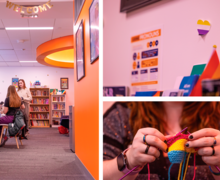Julie Williamson’s creativity, curiosity embedded forever with jersey retirement
Maxine Brackbill | Assistant Photo Editor
After leading Syracuse to a Big East championship in 1993, Julie Williamson became the first field hockey player to have her jersey retired.
To support student journalism and the content you love, become a member of The Daily Orange today.
Julie Williamson sat down in the “old school” stretching circle while assistant coaches Peter Currie and Terri Tipton roamed around in the middle before each practice.
The center of the field turned into a talent show as Currie and Tipton performed their best moves to each other. They had the Y-dodge, the “dink,” which allowed the player to pop the ball down on the turf and bounce it over the opponents’ stick, and the C-dodge, where the player brought their stick around the front of the ball, flipped their stick and moved the ball in the opposite direction.
Mesmerized with the “best stick skills” she’d seen, Williamson knew she could do it too. So Williamson popped up and joined, asking to see the trick one more time before trying it herself.
“I found joy in the challenge of learning a new skill,” Williamson said. “I never saw it as a chore, I always saw it as a chance to try something new to beat my opponent.”
Williamson’s curiosity to be more creative helped her become a commanding force for Syracuse when it won the Big East championship for the first time in 1993. At the time, the title gave womens’ sports “respect” around the school. She was the first SU player to earn three straight All-American honors, and on Sunday, Williamson’s No. 9 became the first to be retired from SU’s field hockey program.
“There’s a whole sea of people going up with that jersey that helped put this program on the map,” Williamson said.
Williamson immediately stood out to former head coach Kathleen Parker at a recruiting event. Parker said Williamson had a “natural ability” that was sometimes hard to teach. While then-sophomore Shelley Mattaliano and her teammates heard rumblings of the recruits, they all knew Williamson was different and would compete for a spot immediately.
“Julie’s skill set was probably a little bit higher than any of the current players I had,” Parker said. “I thought Julie was not only able to perform at that level, but she could take the team to a different level.”

Megan Thompson | Digital Design Director
SU’s turf field excited Williamson since it brought a completely different tone from the grass fields in New Jersey. She glided the ball over the field and expressed her creativity like never before.
Currie said Williamson possessed great hand-eye coordination while keeping the ball close to her stick. She learned the Y-dodge and the C-dodge, and even mastered Tipton’s signature reverse C-dodge.
In 1992, Williamson became the first-ever Orange player to play for the U.S. Women’s National Team. With tougher competition, she had to do everything “faster and smarter.” But she learned other tricks along the way like the reverse sweep, which she brought to Syracuse.
Former teammate Julie Clark said the reverse sweep was relatively new in the sport. It required immense body control, meaning Williamson faced away from the defense, bent her body down to her left side and smacked the backside of her stick at the ball as hard as possible.
“Julie had the ability to run with her back horizontal to the field while dribbling at a very high speed,” Clark said. “Most people can’t do that. She was trying to get ahead and do what the next greatest thing was.”
Williamson didn’t think about it as a reverse sweep, though. Depending on the defense, the move was the only way to get the ball to where she wanted it to go. Parker gave Williamson the “belief” to pull those tricks off in-game.
The end result of Williamson’s tricks was always the same, former teammate Heather O’Neill said. After Williamson scored, the rest of the team saw her leap into the air, seconds after hearing the ringing clang from her shot hitting the back of the goal.
“She would often be the person with the ball in her stick when you needed a goal in the dying seconds of the match,” Currie said. “Somehow Julie had the ball and it was in the back of the net.”

Jacques Megnizin | Design Editor
The 1993 Syracuse team had a feeling it could win the Big East, Mattaliano said. Williamson and Christa Dieffenderfer anchored both sides of the field, using the “kick ass and take names” strategy Williamson’s father instilled in both of them.
But before the Big East Tournament in Boston, Williamson and Bingaman were nowhere to be found. Parker had a rule for the team — once the coach was on the bus, it left.
Clark noticed the two players were missing, so she got in her car to speed over to South Campus. Williamson prepared to call her mom for a ride before Clark’s knock at the door. They drifted back into the parking lot and arrived just as Parker got on the bus.
“I thought there was no way I’m going to the Big East (championship) without Julie or Christa,” Clark said.
After Syracuse’s 3-0 win over Boston College in the semifinals, the championship game versus UConn was back-and-forth, Currie said. Williamson continued to do “an amazing job” and the Orange defeated the Huskies 1-0 for their first conference title.
“I just remember the release of tension from the coaching staff, it was a pretty amazing time,” Currie said.
Syracuse earned its first NCAA Tournament appearance that season, defeating Penn 3-0 in the first round. Instead of a bus, the team boarded a charter plane, one with the NHL’s New Jersey Devils and Buffalo Sabres’ logos plastered on the side.
“It didn’t matter if I got to the game on a bicycle,” Williamson said. “I just wanted to get into the game and play.”
After beating Pennsylvania 3-0, the Orange lost to Penn State 4-0 in the quarterfinals. But Williamson and the rest of the team’s success that season was a “stepping stone” for the increase in importance for womens’ programs at SU, Currie said.
At the time, female athletes only used facilities like the weight room after men were finished at 8 p.m., giving them little time to establish weight programs. When Parker took over the program in 1978, field hockey was more of a glorified club team than the perennial powerhouse it is today. But Williamson rode the shoulders of those from the program’s first decade to lead it to its “defining moment,” which turned the tide forever.
“We built that foundation so it could grow,” Clark said. “And Julie was right in the middle of it.”

Published on October 10, 2022 at 12:26 am
Contact Anish: asvasude@syr.edu | @anish_vasu





